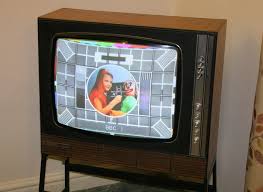Last month, I wrote about some classic old radios. A customer, ex TV engineer, came in during week and we had a walk down TV memory lane.
Colour TV had been around in the USA since the late ‘40s. RCA had developed a system for transmitting colour signals working with the NTSC, National Television Standards Committee. This standard was also known as Never Twice the Same Colour. The system had flaw in that early colour decoder circuits in the TV, struggled to resolve the correct colours. People’s faces would slowly turn green and blue over the course off an evenings viewing. Sets had a colour hue control to compensate, and Chuck would have to get up and adjust every hour or so.
France adopted a colour system called SECAM, Séquentiel couleur à mémoire It was the first European system to be developed, really only used in France. Like most things French, it was a bloody complex system and the colour decoder circuits were a nightmare to work on. Smoke a packet of Gauloises and down a bottle of Dubonet was the best way to attempt a repair.
Britain and most of Europe used a colour system called PAL, Phase Alternating Line. Developed in Germany, it was a simpler system and worked well alongside black and white transmissions.
1967 The start of UK Colour TV!
BBC and ITV had been gearing up for colour. Radio Times proudly highlighted programs that were to be in colour. This was a massive boost to the TV rental businesses. Early Colour sets were not reliable . “Dodgy Bob” round the corner had been repair bodging black and white sets up to now. Colour sets demanded expensive tools and some knowledge. You had to have a good aerial and a strong signal. If not colour would fade in and out.
Philips G6
In ’67, Philips released a monster of a TV chassis. It was a mix of valves and transistors. Very hard to work on. Valves that gave off X-Rays, sterilising the engineers’ nether regions. You needed to be brave. Took 4 of you to get the set upstairs.
GEC
Late ‘60s-‘70s GEC brought out a range of colour sets, Hybrid, a mix of valves and transistors. I have a soft spot for these sets. I bought them, ex-rental, by the car full, change a few parts that were known to go faulty and away the set went for another 5 years. They did however, have a tendency to catch fire. Minor draw back.
Thorn 2000
Now, here we go. ’68, Thorn (Ferguson, Ultra, HMV..) designed an all transistor Colour set! It had about 14 different circuit boards, massive cable looms, loads of preset controls to twiddle in the back. The sets were good and set the way for most makers’ development plans. Other Thorn chassis, 3000-9500 ran into the late ‘80s and were all good.
Mullard made most of the colour TV tubes. Depending on how much the set was used, you might get 6-10 years before the picture went soft as the electron guns lost their emission. Lots of little companies set up, selling “re-gunned” tubes. You took your old tube in, the vacuum would be gently released by carefully breaking the pinch on the neck of the tube. The glass cut and old gun assembly removed. The new gun would be glass welded to the tube and a vacuum pump used to remove the air. Then, you took the tube back, refitted it to the set and spent the next day trying to set it up so the picture was watchable! Some of the re-gunning firms were rubbish!
Seth Pittham. Zeta Services.



